Related Research Articles

Theodor Eicke was a senior SS functionary and Waffen SS divisional commander during the Nazi era. He was one of the key figures in the development of Nazi concentration camps. Eicke served as the second commandant of the Dachau concentration camp from June 1933 to July 1934, and together with his adjutant Michael Lippert, was one of the executioners of SA Chief Ernst Röhm during the Night of the Long Knives purge of 1934. He continued to expand and develop the concentration camp system as the first Concentration Camps Inspector.

Reinhard Gehlen was a German career intelligence officer who served the Weimar Republic, Nazi Germany, the U.S. intelligence community, and the NATO-affiliated Federal Republic of Germany during the Cold War.

The Federal Intelligence Service is the foreign intelligence agency of Germany, directly subordinate to the Chancellor's Office. The BND headquarters is located in central Berlin. The BND has 300 locations in Germany and foreign countries. In 2016, it employed around 6,500 people; 10% of them are military personnel who are formally employed by the Office for Military Sciences. The BND is the largest agency of the German Intelligence Community.

Captain Sigismund Payne Best OBE was a British Secret Intelligence Service agent during the First and Second World Wars. He was captured by German Gestapo and Sicherheitsdienst (SD) men on 9 November 1939 in the Venlo Incident.

Nortorf is a town in the district of Rendsburg-Eckernförde, in Schleswig-Holstein, Germany. It is approximately 13 km northwest of Neumünster, and 25 km southwest of Kiel.

Emanuel Schäfer was a high-ranking SS functionary (SS-Oberführer) and a protégé of Reinhard Heydrich in Nazi Germany.

Josef Blösche was a German war criminal and a member of the Nazi Party who served in the SS and SD during World War II. Blösche personally executed many Jews, participating in several massacres, and helped send many more to their deaths in extermination camps.
Heinz Paul Johann Felfe was a German spy.
Johannes "Hans" Max Clemens was a German functionary of respectively the SS, Sicherheitsdienst was primarily the intelligence service of the SS and the Nazi Party in Nazi Germany. Clemens was also known as the Tiger of Como while serving as a captain in the SS. During the war, he participated in the Ardeatine massacre. Clemens, together with other SS officers, including Herbert Kappler, Karl Hass, Carl-Theodor Schütz, and Erich Priebke, formed the first firing squad, which shot the first 12 victims. After the war, however, Clemens was acquitted of involvement by an Italian military court. He was released and returned to West Germany in 1949.
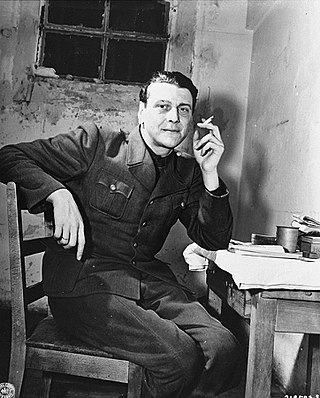
Die Spinne was a post-World War II organisation that helped certain Nazi war criminals escape prosecution. Its existence is still debated to this day. It is believed by some historians to be a different name for, or a branch of ODESSA, an organisation established during the collapse of Nazi Germany, similar to Kameradenwerk and der Bruderschaft, and devoted to helping German war criminals flee Europe. It was led in part by Otto Skorzeny, as well as by German intelligence officer Reinhard Gehlen. Die Spinne helped as many as 600 former SS men escape from Germany to Francoist Spain, Juan Peron's Argentina, Paraguay, Chile, Bolivia, the Middle East and elsewhere.
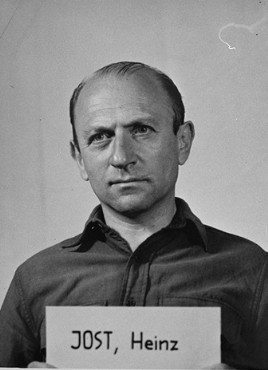
Heinz Jost was a German SS functionary during the Nazi era. He was involved in espionage matters as the Sicherheitsdienst or (SD) section chief of office VI of the Reich Security Main Office. Jost was responsible for genocide in eastern Europe as commander of Einsatzgruppe A from March–September 1942.
The Gehlen Organization or Gehlen Org was an intelligence agency established in June 1946 by U.S. occupation authorities in the United States zone of post-war occupied Germany, and consisted of former members of the 12th Department of the German Army General Staff. It was headed by Reinhard Gehlen who had previously been a Wehrmacht Major General and head of the Nazi German military intelligence in the Eastern Front during World War II.
Foreign Armies East, operated as a military-intelligence organization of the Oberkommando des Heeres (OKH) - the Supreme High Command of the German Army before and during World War II. It focused on analyzing the Soviet Union and other East European countries before and during the war.
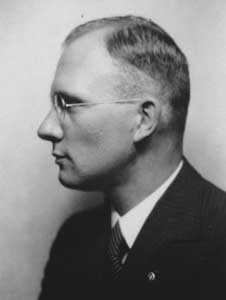
Kurt Paul Werner Lischka was an SS official, Gestapo chief and commandant of the Security police and Security Service in Paris during the German occupation of France in World War II.
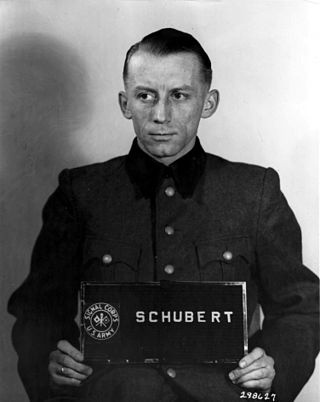
Heinz Hermann Schubert was a German SS officer. He held the rank of Obersturmführer. He was sentenced to death at the Einsatzgruppen Trial in 1948, which was later commuted to 10 years' imprisonment.

Ludwig Hermann Karl Hahn was a German SS-Standartenführer, Nazi official and convicted war criminal. He held numerous positions with the German police and security services over the course of his career with the Schutzstaffel (SS).

Otto Albrecht Alfred von Bolschwing was a German SS-Hauptsturmführer, intelligence officer and international businessman. During the Nazi-era, he served as an operative of the Sicherheitsdienst (SD) in Mandatory Palestine and Romania, where he was involved in instigating the Legionnaires' rebellion and the Bucharest pogrom in 1941. From 1936-39, von Bolschwing worked as a consultant to the Office of Jewish Affairs (Judenreferat) and served as an advisor to Adolf Eichmann in Berlin and Vienna. In 1945, he abandoned his prior allegiance to Nazi Germany and joined the Austrian Resistance.
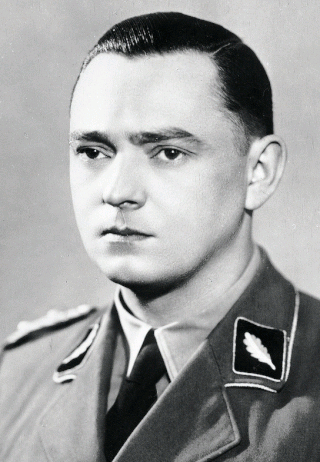
Horst Böhme was a German SS functionary during the Nazi era. He served in the SD, the intelligence service of the SS, and was a leading perpetrator of the Holocaust.

Heinrich Josef Reiser was a German Nazi war criminal, SS officer as well as a member of the Gestapo and the SD. Reiser fought in World War I and was captured. After he was released, he became an electrician and worked in several countries including Brazil. When he returned to Germany in 1931, he became part of the rise of Nazism, his real career, first becoming an SS officer in 1932 and then a Gestapo officer where he worked to round up Jews and communists in Karlsruhe area in the late interwar period and then later in the Czech Republic after the war started. In 1940, he was sent to Paris to work in the Sonderkommando Rote Kapelle. In 1943, Reiser was in line to become the commanding officer of the Sonderkommando Rote Kapelle as a replacement for Karl Giering. He briefly held the position when Giering fell ill but was later transferred back to the Karlsruhe Gestapo towards the end of World War II where he was involved in the repression of forced foreign labourers. From 1950 onward, he was an intelligence officer of the Gehlen Organization and the resulting Federal Intelligence Service. He became a major proponent for the continued existence of anti-Nazi resistance organisations in West Germany after the war, including Red Orchestra and Schwarze Kapelle. This was an attempt to correct the perceived misperceptions of the Gestapo as a criminal organisation by identifying and purging former opponents of the Nazi regime from German public life and public opinion, in operations that were fully supported by the Gehlen organisation.
References
- ↑ "Hans Sommer, from SD to Stasi". cheminsdememoire.gouv.fr. Chemins de Mémoire. Retrieved March 22, 2019.
- 1 2 "Weiße Flecken in der Geschichte des Bundesnachrichtendienstes". Frankfurter Allgemeine Zeitung. May 13, 2008.
- ↑ The Arms of Krupp .p.